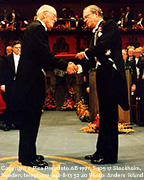Winner of the 1997 Nobel Prize in Chemistry for discovering how ATP synthase produces ATP, which provides energy to cells of all living organisms.

Paul D. Boyer shared the 1997 Nobel Prize in Chemistry for figuring out how the enzyme ATP synthase catalyzes the formation of ATP (adenosine triphosphate), a molecule essential for life because it transfers energy within cells of all living organisms, from bacteria and fungi to plants and animals, including humans.
ATP synthase works by capturing the chemical energy released from the metabolism of nutrients and making it available to create cell components and carry out a myriad of cellular functions. It is often called the cell's “energy currency.”
A leading enzymologist of the 20th century, Boyer began his research as an assistant professor of biochemistry at the University of Minnesota in 1945, where he worked on kinetic, isotopic and chemical methods for exploring enzyme mechanisms. His work earned him a Guggenheim Fellowship and Hill Foundation Professorship. He began his studies of ATP formation at Minnesota in the early 1950s, with the goal of using isotope techniques to understand how ATP synthase produces ATP. It was a challenging goal because ATP synthase has a unique mechanism of action.
In 1963, Boyer joined the faculty of the University of California at Los Angeles, where he became founding director of the Institute for Molecular Biology. His ongoing studies of ATP synthase ultimately revealed the mechanism of a “beautiful molecular machine” that made ATP available to cells. [See illustration.] At the time, there was no way to confirm the accuracy of his theory; so when he retired in 1989, he didn’t know if he had succeeded of failed.
Boyer shared the Nobel Prize with John Walker of Cambridge University and Jens Skou of Arrhus University in Denmark. Walker established the structure of the enzyme and confirmed Boyer’s proposed mechanism; Skou discovered an enzyme related to ATP synthase that maintains the balance of sodium and potassium ions in a living cell.
Boyer’s original sketches of his mechanism are displayed on the Wall of Discovery, which is adjacent on the University of Minnesota’s Minneapolis campus.
Born in Provo, Utah, in 1918 Paul Boyer earned a B.S. in chemistry from the University of Wisconsin, Madison. In 1946, after postdoctoral research at Stanford University, he came to the University of Minnesota, where he was a member of the biochemistry faculty for 17 years. He and his wife, Lyda, had three children and eight grandchildren. At the time of this writing (December, 2013) their grandson, Josh Boyer, was working on his Ph.D. in immunology at the U of M Medical School.
Boyer and James Peter, a former postdoctoral fellow in Boyer’s lab, established a scholarship for undergraduate students majoring in biochemistry at the College of Biological Sciences.